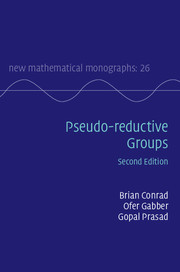Book contents
- Frontmatter
- Dedication
- Contents
- Preface to the second edition
- Introduction
- Terminology, conventions, and notation
- PART I Constructions, examples, and structure theory
- PART II Standard presentations and their applications
- PART III General classification and applications
- 7 The exotic constructions
- 8 Preparations for classification in characteristics 2 and 3
- 9 Absolutely pseudo-simple groups in characteristic 2
- 10 General case
- 11 Applications
- PART IV Appendices
- References
- Index
7 - The exotic constructions
from PART III - General classification and applications
Published online by Cambridge University Press: 05 June 2015
- Frontmatter
- Dedication
- Contents
- Preface to the second edition
- Introduction
- Terminology, conventions, and notation
- PART I Constructions, examples, and structure theory
- PART II Standard presentations and their applications
- PART III General classification and applications
- 7 The exotic constructions
- 8 Preparations for classification in characteristics 2 and 3
- 9 Absolutely pseudo-simple groups in characteristic 2
- 10 General case
- 11 Applications
- PART IV Appendices
- References
- Index
Summary
Calculations in characteristics 2 and 3
Over imperfect fields k of characteristics 2 and 3 there are pseudo-reductive groups that are not standard. Interesting classes of such groups (to be called exotic) were discovered by Tits, resting on special properties of the group G2 in characteristic 3 and the group F4 in characteristic 2, as well as groups in characteristic 2 of type Bn and Cn with n ≥ 2. A basic common feature of these types is that the unique pair of non-orthogonal positive simple roots {a, b} with distinct root lengths, say with a long and b short, satisfies. In other words, the Dynkin diagram has an edge with multiplicity p.
The definition of exotic pseudo-reductive k-groups requires a lot of preparation (essentially all of §§7.1 and 7.2), due to the intervention of subtleties related to the field of definition over k of a Levi ks-subgroup (see Example 7.2.2). The case of G2 provides everything we need for a complete result in characteristic 3.
Tits' method for constructing exotic examples in characteristics 2 and 3 uses general axiomatic arguments with root systems that he sketched in [Ti2, §5] over a separably closed field (and applied to the root systems of a split G2 in characteristic 3 and a split F4 in characteristic 2, as well as variants for types B and C in rank ≥ 2 in characteristic 2). We will use an alternative approach that is well suited to working with arbitrary k-forms of type G2 (resp. types F4 and Bn and Cn with n ≥ 2) for any imperfect k of characteristic 3 (resp. 2). This section largely focuses on the calculations with (forms of) these types that underlie the constructions to be given in §7.2.
Let k be an arbitrary field of characteristic p ∈ {2, 3}, and let G be a connected semisimple k-group that is absolutely simple and simply connected with Dynkin diagram having an edge with multiplicity p. We do not assume that G is k-split.
Information
- Type
- Chapter
- Information
- Pseudo-reductive Groups , pp. 229 - 264Publisher: Cambridge University PressPrint publication year: 2015
